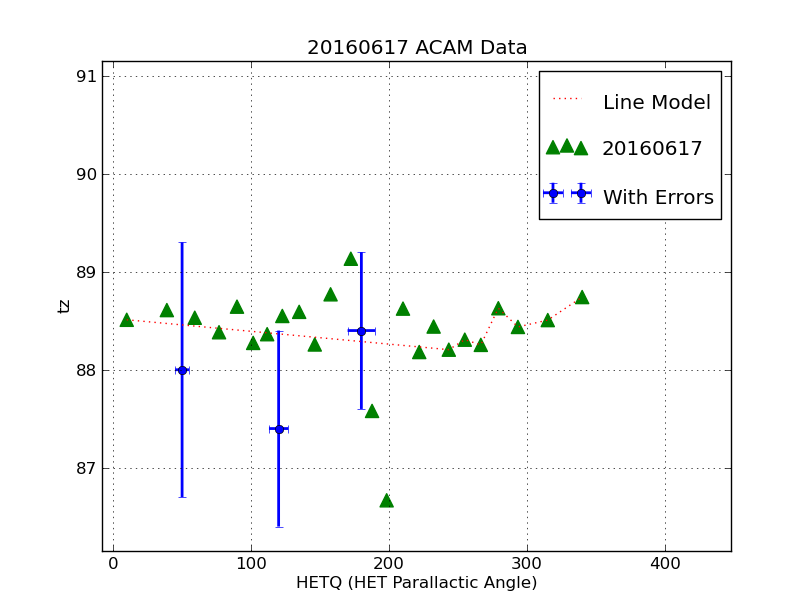 |
An example of a plot I made with the command line:
pxy_SM_plot.py style.hetq-tz 0 360 86 91 SHOW |
This is a plotting package that uses the MATLAB-like plotting package matplotlib.pyplot. I never use MATLAB, but the pyplot documentation seems to be pervasive, especially among astronomers. As of August 2016 I can plot data points, lines and error bars. I can direct the plot to a hardcopy file (named pxy.png) or I can specify that each plot go to the interactive show() gui. Note that this routine is rarely used directly from the command line. Rather, I run it is more-friencly scripts like xyplotter_auto or xyplotter.
I wrote a script named mpl that provides a brief summary of point type a color properties.
% pxy_SM_plot.py --help usage: pxy_SM_plot.py [-h] [-v] arg1 arg2 arg3 arg4 arg5 arg6 positional arguments: arg1 input data file arg2 low value for X axis arg3 high value for X axis arg4 low value for Y axis arg5 high value for Y axis arg6 display method = HARD or SHOW optional arguments: -h, --help show this help message and exit -v, --verbose Verbose responsesThe last argument specifies whether I want to display the plot interactively (with show()) or just send the plot to a hard-copy file named pxy.png. As of Aug2016, this code will plot points, lines, and errorbars. I show a basic example below.
To interactively view the plot: % pxy_SM_plot.py style.hetq-tz 0 360 86 91 SHOW To directly make a hardcopy: % pxy_SM_plot.py style.hetq-tz 0 360 86 91 HARD The input files I use are: style.hetq-tz ===> Give axis labels and lists the data sets to be plotted. % cat style.hetq-tz 20160617 ACAM Data HETQ (HET Parallactic Angle) tz UT20160617-hetq-tz.file UT20160617-hetq-tz.file_1 UT20160617-hetq-tz.file_2 Possible type of marking: point , line, errorbar % cat UT20160617-hetq-tz.file point g ^ 90 # type of marking, color, marker code, size 20160617 # label name 9.864 88.510 38.954 88.609 59.190 88.531 76.780 88.383 89.806 88.644 ..... 279.311 88.628 293.520 88.437 315.167 88.507 340.091 88.742 Here I plot a line or curve: % cat UT20160617-hetq-tz.file_1 line r : 30 Line Model 9.864 88.510 243.402 88.205 254.989 88.307 266.616 88.254 279.311 88.628 293.520 88.437 315.167 88.507 340.091 88.742 Here I plot points with error bars: % cat UT20160617-hetq-tz.file_2 errorbar b o 100 With Errors 50.0 5.0 88.0 1.3 180.0 10.0 88.4 0.8 120.0 7.0 87.4 1.0Below I show the plot I made with these data files when I used the "SHOW" mode. I adjusted the axis properties a little and then made a hardcopy file with a custon name. I show the file below.
 |
An example of a plot I made with the command line:
pxy_SM_plot.py style.hetq-tz 0 360 86 91 SHOW |
We can plot a variety of marker and line types. I got some of these simple commands from a somewhat useful pyplot tutorial in the online matplotlib docucumentation. Note that I added a lot of things by adding just a few lines to the procedure. One thing to now that that instead of using plt.scatter() to plot points, I use the plt.plot() command. I specify that red dots are to be plotter using the 'ro' argument. I'll nver remember that bullshit, but here is a simple table:
Other options for the color characters are: 'r' = red 'g' = green 'b' = blue 'c' = cyan 'm' = magenta 'y' = yellow 'k' = black 'w' = white Options for line styles are '-' = solid '--' = dashed ':' = dotted '-.' = dot-dashed '.' = points 'o' = filled circles '^' = filled triangles The other thing to do (in ipython) to get a load of information: In [33]: plt.plot? When I did this I got a bigger chart: The following color abbreviations are supported: ========== ======== character color ========== ======== 'b' blue 'g' green 'r' red 'c' cyan 'm' magenta 'y' yellow 'k' black 'w' white ========== ======== ================ =============================== character description ================ =============================== ``'-'`` solid line style ``'--'`` dashed line style ``'-.'`` dash-dot line style ``':'`` dotted line style ``'.'`` point marker ``','`` pixel marker ``'o'`` circle marker ``'v'`` triangle_down marker ``'^'`` triangle_up marker ``'<'`` triangle_left marker ``'>'`` triangle_right marker ``'1'`` tri_down marker ``'2'`` tri_up marker ``'3'`` tri_left marker ``'4'`` tri_right marker ``'s'`` square marker ``'p'`` pentagon marker ``'*'`` star marker ``'h'`` hexagon1 marker ``'H'`` hexagon2 marker ``'+'`` plus marker ``'x'`` x marker ``'D'`` diamond marker ``'d'`` thin_diamond marker ``'|'`` vline marker ``'_'`` hline marker ================ ===============================The thing to notice is that you can use the marker types above to specify whether you want LINES or MARKERS. I can do most of what I usually need using plt.plot() alone! And Finally: A very nice feature about using the "plt.show() command is that the legends stay in place. You can use the arrow box icon to change the scale and placement of your points in the plot, but if you used loc=3 in the setting up the legen location, then that legend box STAYS in the lower-left corner. This is a nice feature and one I wish I had known about long ago!